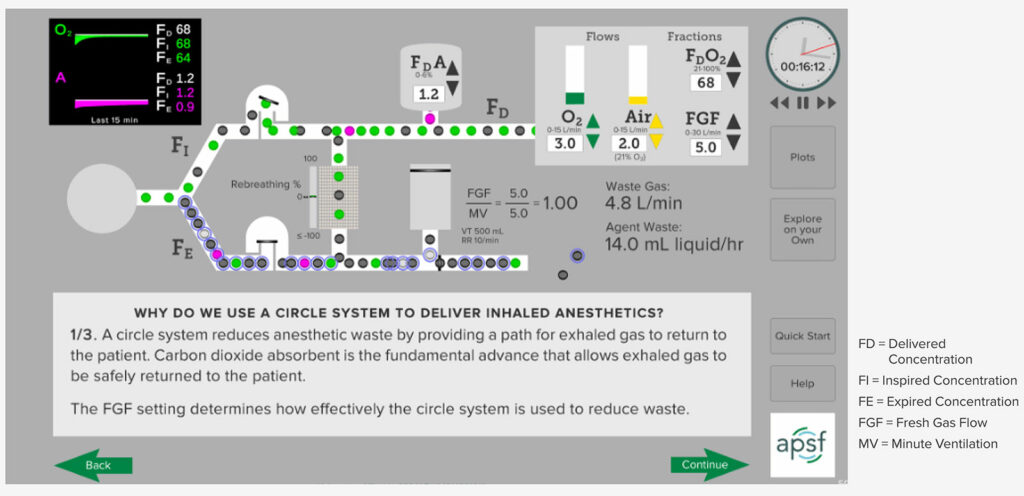Course: APSF.ORG/TEI/LFA
Ever wonder how much you can reduce fresh gas flow safely? Did you know that significantly reducing anesthetic pollution requires attention to lowering flows during not just the maintenance phase of an anesthetic, but induction and emergence as well? What about Compound A and sevoflurane—is it safe to deliver sevoflurane using a fresh gas flow less than 2 L/min? Does the choice of CO2 absorbent matter as fresh gas flow is reduced? These and other questions are answered in the newly released APSF course on low-flow anesthesia.
At the 2022 annual meeting of the American Society of Anesthesiologists (ASA), the Anesthesia Patient Safety Foundation (APSF), in collaboration with the ASA, launched its Technology Education Initiative with an inaugural course on Low-Flow Anesthesia. The course is intended to empower anesthesia professionals with the knowledge required to safely, effectively, and comfortably reduce fresh gas flow. The course utilizes guided simulation to help the learner understand the interaction between fresh gas flow setting and anesthetic waste and pollution (Figure 1). There is an emphasis on patient safety and the central role of monitoring oxygen and anesthetic concentrations to ensure safe and adequate oxygen and anesthetic delivery as fresh gas flow is reduced. Eight different topics, each requiring about 15 minutes, cover the essentials of low-flow anesthesia and strategies during each phase of the anesthetic. While the topics are recommended to be done in sequence, they do not need to be done all at the same time.
APSF Technology Education Initiative—Low-Flow Anesthesia—Using the Circle System to Control Breathing

Figure 1. Snapshot of guided simulation from the APSF/ASA course on low-flow anesthesia. The user is guided on adjusting fresh gas flow, oxygen concentration, and vaporizer setting while visualizing the impact on anesthetic waste as well as the resulting concentrations of oxygen and anesthetic in the circuit. (APSF.ORG/tei/lfa)
The course is available online through the ASA Education Center. Any anesthesia professional or interested party can take the course free of charge by creating a guest account if they are not an ASA member. Three continuing education credits are available for physicians, CRNAs, and CAAs. For those in the MOCA® process, all of the continuing medical education (CME) credits are patient safety-eligible. Although the actual course is hosted by the ASA, there is a landing page on the APSF website with expanded information on low-flow anesthesia. Interested professionals are encouraged to begin by accessing the APSF website at APSF.ORG/tei/lfa where you will find the following information:
- Introductory tour of the simulation platform
- Link to the course on the ASA website
- Supplemental information
- Technology and Low-Flow Anesthesia Practice: Article describing the various tools available in different anesthesia machine models to support a low-flow practice.
- Is Rebreathing Prevented when FGF Equals MV? Article describing the relationship between FGF, minute ventilation, and rebreathing.
- Global Warming—Blame Anesthesia? Article describing the environmental rationale for practicing low-flow anesthesia.
- Explore the Simulation on Your Own: This provides access to an unguided version of the anesthesia machine model and simulation where learners can trial different approaches to managing fresh gas flow during induction, maintenance, and emergence.
- Links to websites of anesthesia delivery system manufacturers for more detailed information about specific devices.
At the time of this writing, hundreds of anesthesia professionals have visited the APSF webpage and signed up for the course. The simulation approach is interactive and replaces traditional didactic teaching with a learning environment where the functions of the anesthesia machine can be readily visualized. Informative, available continuing education credits and it’s FREE! Why wait? Sign up and take the course today.


 Issue PDF
Issue PDF PDF
PDF